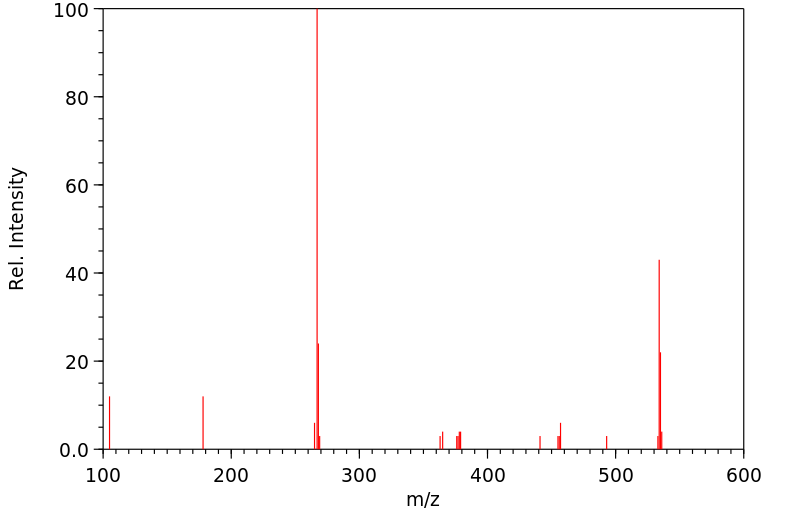1,1',2,2',3,3'-六苯基-1,1'-联(2-环丙烯) | 4997-62-0
分子结构分类
中文名称
1,1',2,2',3,3'-六苯基-1,1'-联(2-环丙烯)
中文别名
——
英文名称
hexaphenyl-[3,3']bicycloprop-1-enyl
英文别名
3,3'-Bis-(triphenylcyclopropenyl);Bis-triphenylcyclopropenyl;Bistriphenylcyclopropenyl;Benzene, 1,1',1'',1''',1'''',1'''''-(bi-2-cyclopropen-1-yl)-1,1',2,2',3,3'-hexaylhexakis-;[2,3-diphenyl-1-(1,2,3-triphenylcycloprop-2-en-1-yl)cycloprop-2-en-1-yl]benzene
CAS
4997-62-0
化学式
C42H30
mdl
——
分子量
534.7
InChiKey
DQELQSOUCKXCIO-UHFFFAOYSA-N
BEILSTEIN
——
EINECS
——
-
物化性质
-
计算性质
-
ADMET
-
安全信息
-
SDS
-
制备方法与用途
-
上下游信息
-
文献信息
-
表征谱图
-
同类化合物
-
相关功能分类
-
相关结构分类
计算性质
-
辛醇/水分配系数(LogP):9.6
-
重原子数:42
-
可旋转键数:7
-
环数:8.0
-
sp3杂化的碳原子比例:0.05
-
拓扑面积:0
-
氢给体数:0
-
氢受体数:0
SDS
反应信息
-
作为反应物:参考文献:名称:THE SYNTHESIS OF BIS-TRIPHENYLCYCLOPROPENYL, AN UNDISSOCIATED DIMER OF THE TRIPHENYLCYCLOPROPENYL RADICAL, AND ITS ISOMERIZATION TO HEXAPHENYLBENZENE摘要:DOI:10.1021/ja01526a077
-
作为产物:描述:1,2,3-triphenylcyclopropenyl-3-ium tetrafluoroborate 在 chromium dichloride 作用下, 以 盐酸 为溶剂, 生成 1,1',2,2',3,3'-六苯基-1,1'-联(2-环丙烯)参考文献:名称:碳正离子的单电子还原。V. 用 Cr(II) 还原取代的环丙烯离子的动力学研究摘要:一系列苯基和/或正丙基取代的环丙烯鎓离子与 Cr(II) 的单电子还原已在 10% HCl 溶液中进行。三苯基环丙烯 (Ia)、二苯基-正-丙基环丙烯 (Ib) 和苯基二-正-丙基环丙烯 (Ic) 离子的还原定量得到各自环丙烯基的二聚体,即双(环丙烯基)衍生物,而三-n -丙基环丙烯鎓离子 (Id) 非常不活泼。动力学研究表明,这些稳定的碳正离子对单电子还原剂(Cr(II))的反应性随着苯基取代基数量的减少而降低:k225°C=3.0×10-4l/g- Ia 为 ion·s,Ib 为 2.7×10-6l/g-ion·s,Ic 为 2.8×10-9l/g-ion·s,Id 为 <10-11l/g-ion·s。发现添加的 NaCl 会加速 Ia 的还原速率,而添加的 HCl 显示出初始速率增强效应,随后是轻微的速率延迟效应。logk2 与相应阳离子的电子亲和力的关系图,估计...DOI:10.1246/bcsj.46.3881
文献信息
-
Metal-Catalyzed Cyclopropene Rearrangements for Benzannulation: Evaluation of an Anthraquinone Synthesis Pathway and Reevaluation of the Parallel Approach via Carbene-Chromium Complexes作者:M. F. Semmelhack、Suzzy Ho、D. Cohen、M. Steigerwald、M. C. Lee、G. Lee、Adam M. Gilbert、William D. Wulff、Richard G. BallDOI:10.1021/ja00095a014日期:1994.8The reaction of 3-arylcyclopropenes with Cr(CO)(6) and Mo(CO)(6) produces naphthols, in an example of metal-promoted benzannulation. Substituents at C-3 (in addition to aryl) have a strong effect on the success of the process: 3-H derivatives are generally effective, but the yields decrease for 3-alkyl derivatives as the size of the alkyl group increases. The 3,3-diphenyl and 3-cyano derivatives are unreactive. The mechanism is postulated to involve metal-complexed vinyl carbene units, parallel with the benzannulation reaction involving arylcarbene complexes with alkynes. The regioselectivity has been probed with various unsymmetrically 1,2-disubstituted 3-arylcyclopropenes. The results suggest a simple correlation with steric size, consistent with initial cleavage of the cyclopropene sigma bond bearing the smaller substituent. The result of this regioselectivity is a product structure showing a substituent arrangement opposite to that from the carbene-chromium approach; the smaller substituent of the cyclopropyl double bond ends up adjacent to the phenol OH in the product. Catalytic activity at low efficiency was observed, using a Mo(CO)a catalyst. However, the use of Mo(CO)(6) also promotes formation of indenes as significant byproducts at the expense of naphthalenes. Attempts to use the arylcyclopropene rearrangement to convert a 3-(1,4-dimethoxy-2-naphthyl)cyclopropene to an anthraquinone skeleton produced instead a phenanthrene via an unusual substitution for a methoxy substituent. A related example previously reported to produce anthraquinones via the naphthylcarbene-chromium/ alkyne reaction was shown to be in error; the correct structure is again a phenanthrone, and the product is exactly parallel with that observed in the cyclopropene rearrangement. A naphthoquinone substituted with a cyclopropene at C-2 does provide the first example of metal-promoted benzannulation to give an anthraquinone.
-
Isomerization of Biscyclopropenyls to Benzenes<sup>1,2</sup>作者:Ronald Breslow、Peter Gal、Hai Won Chang、L. J. AltmanDOI:10.1021/ja00950a028日期:1965.11
-
Gompper,R. et al., Chemische Berichte, 1979, vol. 112, p. 218 - 233作者:Gompper,R. et al.DOI:——日期:——
表征谱图
-
氢谱1HNMR
-
质谱MS
-
碳谱13CNMR
-
红外IR
-
拉曼Raman
-
峰位数据
-
峰位匹配
-
表征信息
同类化合物
苯基(2,4,5-三苯基-2-环戊烯-1-基)甲酮
肠二醇
珠子草素
开环异落叶松树脂酚
安五脂素
外消旋肠二醇-13C3
去甲二氢愈创木酸
半去甲二氢愈创木酸
二甲基2,5-二苯基-3,4-二氢-2H-吡咯-3,4-二羧酸酯
二氢荜澄茄脂素
9,9'-二-O-(E)-阿魏酰开环异落叶松脂素
5,6-二甲基-5-苯基-1,3-环己二烯
4-[4-(4-羟基-3-甲氧基苯基)-2,3-二甲基丁基]-2-甲氧基苯酚
2-甲氧基-1,2,3,4-四苯基丁烷-1,4-二酮
2,6-二甲氧基-4-羟基苯甲醛
2,6-二甲氧基-4-[(2R,3R)-4-甲氧基-3-[(7-甲氧基-1,3-苯并二噁唑-5-基)甲基]-2-(甲氧基甲基)丁基]苯酚
2,3-双[(4-羟基-3-甲氧基苯基)甲基]丁烷-1,4-二醇
2,3-双[(3,4-二甲氧基苯基)甲基]丁烷-1,4-二醇
2,3-双[(3,4-二甲氧基苯基)甲基]丁二酸
2,3-双(4-羟基-3-甲氧基苄基)琥珀酸二甲酯
2,3-双(3,4-二甲氧基苄基)-4-甲氧基-4-氧代丁酸
2,3-二苄基丁烷-1,4-二醇
2,3-二甲基-1,4-二苯基丁烷-2,3-二醇
2,3-二甲基-1,4-二苯基丁烷-1,4-二酮
2,3-二异丙基-1,2-二苯基-1,4-丁二酮
2,3-二[(3-羟基苯基)甲基]丁烷-1,4-二醇
2,2,3,3-四甲基-1,4-二苯基丁烷-1,4-二酮
1,4-丁烷二酮
1,2,3,4-四苯基环戊烷
1,2,3,4-四苯基丁烷
1,2,3,4-四苯基-1,4-丁烷二酮
1,2,3,4-四-(4-甲氧基-苯基)-丁烷-1,4-二酮
1,1'-[(2S,3S)-2,3-双(甲氧基甲基)-1,4-丁二基]双[3,4-二甲氧基苯]
1,1'-(2,3-二甲基-1,4-丁烷二基)二(3,4-二甲氧基苯)
1,1',2,2',3,3'-六苯基-1,1'-联(2-环丙烯)
(3,3,4,4-四甲基-2-苯基环丁烯-1-基)苯
(2R,3S)-1,4-二(4-羟基-3-甲氧基苯基)-2,3-二甲基丁烷-1-酮
(-)-二氢愈创木脂酸
(+)-开环异落叶松树脂酚
(2S,3R)-2,3-Bis-(3,5-di-tert-butyl-4-hydroxy-benzyl)-butane-1,4-diol
(3-{1-[(E)-2-(4-Methoxy-phenyl)-1-methyl-vinyl]-3,3-dimethyl-1,3-dihydro-isobenzofuran-1-yl}-propyl)-dimethyl-amine
(6-Benzoyl-1,4-diphenyl-3,6-di-p-tolyl-tetrahydro-isoxazolo[4,3-c]isoxazol-3-yl)-phenyl-methanone
2-(1,3-Diphenylpropan-2-yl)-2-methylpropane-1,3-diol
1-hydroxy-6-(3-oxo-3-phenylpropyl)-4,4-diphenyl-2,3-dioxabicyclo[4.3.0]nonan-7-one
2-[2-(3,4-dimethoxy-phenyl)-1-methyl-ethyl]-3-phenyl-oxaziridine
1,3,5-triphenyl-pyrrolidine-2,2,4-tricarboxylic acid trimethyl ester
3-Methyl-1-phenyl-cyclopropane-1,2-dicarboxylic acid diethyl ester
2-Benzoyl-3-(4-methoxy-phenyl)-5-oxo-5-p-tolyl-pentanoic acid ethyl ester







